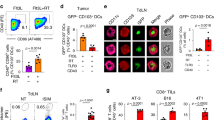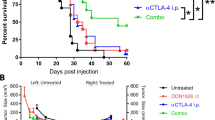Abstract
Targeting interleukin-2 (IL-2) and/or agonist anti-CD40 antibody (Ab) into tumors represents an effective vaccination strategy that avoids systemic toxicity and resolves treated-site tumors. Here, we examined IL-2 and/or anti-CD40 Ab-driven local versus systemic T cell function and the installation of T cell memory. Single tumor studies showed that IL-2 induced a potent CD4+ and CD8+ T cell response that was limited to the draining lymph node and treated-site tumor, and lymph node tumor-specific CD8+ T cells did not upregulate CD44. A two-tumor model showed that while IL-2-treated-site tumors resolved, distal tumors continued to grow, implying limited systemic immunity. In contrast, anti-CD40 Ab treatment with or without IL-2 expanded the systemic T cell response to non-draining lymph nodes, and distal tumors resolved. Tumor-specific T cells in lymph nodes of anti-CD40 Ab ± IL-2-treated mice upregulated CD44, demonstrating activation and transition to effector/memory migratory cells. While CD40-activated CD4+ T cells were not required for eradicating treated-site tumors, they, plus CD8+ T cells, were crucial for removing distal tumors. Rechallenge/depletion experiments showed that the effector/memory phase required the presence of previously CD40/IL-2-activated CD4+ and CD8+ T cells to prevent recurrence. These novel findings show that different T cell effector mechanisms can operate for the eradication of local treated-site tumors versus untreated distal tumors and that signaling through CD40 generates a whole of body, effector/memory CD4+ and CD8+ T cell response that is amplified and prolonged via IL-2. Thus, successful immunotherapy needs to generate collaborating CD4+ and CD8+ T cells for a complete long-term protective cure.





Similar content being viewed by others
Abbreviations
- Ab:
-
Antibody
- i.t.:
-
Intratumoral
- dLN:
-
Draining lymph node
- non-dLN:
-
Non-draining lymph node
References
Hargadon KM, Brinkman CC, Sheasley-O’neill SL, Nichols LA, Bullock TN, Engelhard VH (2006) Incomplete differentiation of antigen-specific CD8 T cells in tumor-draining lymph nodes. J Immunol 177:6081–6090
Nelson DJ, Mukherjee S, Bundell C, Fisher S, van Hagen D, Robinson B (2001) Tumor progression despite efficient tumor antigen cross-presentation and effective “arming” of tumor antigen-specific CTL. J Immunol 166:5557–5566
Spiotto MT, Yu P, Rowley DA, Nishimura MI, Meredith SC, Gajewski TF et al (2002) Increasing tumor antigen expression overcomes “ignorance” to solid tumors via cross presentation by bone marrow-derived stromal cells. Immunity 17:737–747
Thompson ED, Enriquez HL, Fu YX, Engelhard VH (2010) Tumor masses support naive T cell infiltration, activation, and differentiation into effectors. J Exp Med 207:1791–1804
Radoja S, Saio M, Schaer D, Koneru M, Vukmanovic S, Frey AB (2001) CD8(+) tumor-infiltrating T cells are deficient in perforin-mediated cytolytic activity due to defective microtubule-organizing center mobilization and lytic granule exocytosis. J Immunol 167:5042–5051
Zippelius A, Batard P, Rubio-Godoy V, Bioley G, Lienard D, Lejeune F et al (2004) Effector function of human tumor-specific CD8 T cells in melanoma lesions: a state of local functional tolerance. Cancer Res 64:2865–2873
Huang H, Hao S, Li F, Ye Z, Yang J, Xiang J (2007) CD4+ Th1 cells promote CD8+ Tc1 cell survival, memory response, tumor localization and therapy by targeted delivery of interleukin 2 via acquired pMHC I complexes. Immunology 120:148–159
Thorne SH, Liang W, Sampath P, Schmidt T, Sikorski R, Beilhack A et al (2010) Targeting localized immune suppression within the tumor through repeat cycles of immune cell-oncolytic virus combination therapy. Mol Ther 18:1698–1705
Rosendahl A, Kristensson K, Carlsson M, Skartved NJ, Riesbeck K, Sogaard M et al (1999) Long-term survival and complete cures of B16 melanoma-carrying animals after therapy with tumor-targeted IL-2 and SEA. Int J Cancer 81:156–163
Zhao X, Bose A, Komita H, Taylor JL, Kawabe M, Chi N et al (2010) Intratumoral IL-12 gene therapy results in the crosspriming of Tc1 cells reactive against tumor-associated stromal antigens. Mol Ther 19:805–814
Jackaman C, Lew AM, Zhan Y, Allan JE, Koloska B, Graham PT et al (2008) Deliberately provoking local inflammation drives tumors to become their own protective vaccine site. Int Immunol 20:1467–1479
Jackaman C, Bundell CS, Kinnear BF, Smith AM, Filion P, van Hagen D et al (2003) IL-2 intratumoral immunotherapy enhances CD8+ T cells that mediate destruction of tumor cells and tumor-associated vasculature: a novel mechanism for IL-2. J Immunol 171:5051–5063
Jackaman C, Cornwall S, Graham PT, Nelson DJ (2011) CD40-activated B cells contribute to mesothelioma tumor regression. Immunol Cell Biol 89:255–267
Sterman DH, Haas A, Moon E, Recio A, Schwed D, Vachani A et al (2011) A Trial of intrapleural adenoviral-mediated interferon-{alpha}2b gene transfer for malignant pleural mesothelioma. Am J Respir Crit Care Med. doi:10.1164/rccm.201103-0554CR
Sterman DH, Recio A, Carroll RG, Gillespie CT, Haas A, Vachani A et al (2007) A phase I clinical trial of single-dose intrapleural IFN-beta gene transfer for malignant pleural mesothelioma and metastatic pleural effusions: high rate of antitumor immune responses. Clin Cancer Res 13:4456–4466
Bazan-Peregrino M, Seymour LW, Harris AL (2007) Gene therapy targeting to tumor endothelium. Cancer Gene Ther 14:117–127
Gerber HP, Senter PD, Grewal IS (2009) Antibody drug-conjugates targeting the tumor vasculature: current and future developments. MAbs 1:247–253
Bennett SR, Carbone FR, Karamalis F, Flavell RA, Miller JF, Heath WR (1998) Help for cytotoxic-T-cell responses is mediated by CD40 signalling. Nature 393:478–480
Schoenberger SP, Toes RE, van der Voort EI, Offringa R, Melief CJ (1998) T-cell help for cytotoxic T lymphocytes is mediated by CD40-CD40L interactions. Nature 393:480–483
French RR, Chan HT, Tutt AL, Glennie MJ (1999) CD40 antibody evokes a cytotoxic T-cell response that eradicates lymphoma and bypasses T-cell help. Nat Med 5:548–553
Tutt AL, O’Brien L, Hussain A, Crowther GR, French RR, Glennie MJ (2002) T cell immunity to lymphoma following treatment with anti-CD40 monoclonal antibody. J Immunol 168:2720–2728
Cardin RD, Brooks JW, Sarawar SR, Doherty PC (1996) Progressive loss of CD8+ T cell-mediated control of a gamma-herpesvirus in the absence of CD4+ T cells. J Exp Med 184:863–871
von Herrath MG, Yokoyama M, Dockter J, Oldstone MB, Whitton JL (1996) CD4-deficient mice have reduced levels of memory cytotoxic T lymphocytes after immunization and show diminished resistance to subsequent virus challenge. J Virol 70:1072–1079
Fransen MF, Sluijter M, Morreau H, Arens R, Melief CJ (2011) Local activation of CD8 T cells and systemic tumor eradication without toxicity via slow release and local delivery of agonistic CD40 antibody. Clin Cancer Res 17:2270–2280
van Mierlo GJ, den Boer AT, Medema JP, van der Voort EI, Fransen MF, Offringa R et al (2002) CD40 stimulation leads to effective therapy of CD40(−) tumors through induction of strong systemic cytotoxic T lymphocyte immunity. Proc Natl Acad Sci USA 99:5561–5566
Stumbles PA, Himbeck R, Frelinger JA, Collins EJ, Lake RA, Robinson BW (2004) Cutting edge: tumor-specific CTL are constitutively cross-armed in draining lymph nodes and transiently disseminate to mediate tumor regression following systemic CD40 activation. J Immunol 173:5923–5928
Kedl RM, Jordan M, Potter T, Kappler J, Marrack P, Dow S (2001) CD40 stimulation accelerates deletion of tumor-specific CD8(+) T cells in the absence of tumor-antigen vaccination. Proc Natl Acad Sci USA 98:10811–10816
Lai YP, Lin CC, Liao WJ, Tang CY, Chen SC (2009) CD4+ T cell-derived IL-2 signals during early priming advances primary CD8+ T cell responses. PLoS One 4:e7766
Williams MA, Tyznik AJ, Bevan MJ (2006) Interleukin-2 signals during priming are required for secondary expansion of CD8+ memory T cells. Nature 441:890–893
Shrikant P, Mescher MF (1999) Control of syngeneic tumor growth by activation of CD8+ T cells: efficacy is limited by migration away from the site and induction of nonresponsiveness. J Immunol 162:2858–2866
Bos R, Sherman LA (2010) CD4+ T-cell help in the tumor milieu is required for recruitment and cytolytic function of CD8+ T lymphocytes. Cancer Res 70:8368–8377
Maas RA, Dullens HF, De Jong WH, Den Otter W (1989) Immunotherapy of mice with a large burden of disseminated lymphoma with low-dose interleukin 2. Cancer Res 49:7037–7040
Vaage J (1991) Peri-tumor interleukin-2 causes systemic therapeutic effect via interferon-gamma induction. Int J Cancer 49:598–600
Shrikant P, Mescher MF (2002) Opposing effects of IL-2 in tumor immunotherapy: promoting CD8 T cell growth and inducing apoptosis. J Immunol 169:1753–1759
Huet S, Groux H, Caillou B, Valentin H, Prieur AM, Bernard A (1989) CD44 contributes to T cell activation. J Immunol 143:798–801
Baaten BJ, Li CR, Deiro MF, Lin MM, Linton PJ, Bradley LM (2010) CD44 regulates survival and memory development in Th1 cells. Immunity 32:104–115
Schrama D, Xiang R, Eggert AO, Andersen MH, Pedersen Ls LO, Kampgen E et al (2004) Shift from systemic to site-specific memory by tumor-targeted IL-2. J Immunol 172:5843–5850
Van Es RJ, Baselmans AH, Koten JW, Van Dijk JE, Koole R, Den Otter W (2000) Perilesional IL-2 treatment of a VX2 head-and-neck cancer model can induce a systemic anti-tumour activity. Anticancer Res 20:4163–4170
Johnson P, Ruffell B (2009) CD44 and its role in inflammation and inflammatory diseases. Inflamm Allergy Drug Targets 8:208–220
Mescher MF, Curtsinger JM, Agarwal P, Casey KA, Gerner M, Hammerbeck CD et al (2006) Signals required for programming effector and memory development by CD8+ T cells. Immunol Rev 211:81–92
Fransen MF, van Stipdonk MJ, Sluijter M, Schoenberger SP, Melief CJ, Offringa R (2010) Separate roles for antigen recognition and lymph node inflammation in CD8+ memory T cell formation. J Immunol 185:3167–3173
Lee BO, Hartson L, Randall TD (2003) CD40-deficient, influenza-specific CD8 memory T cells develop and function normally in a CD40-sufficient environment. J Exp Med 198:1759–1764
Sun JC, Bevan MJ (2004) Cutting edge: long-lived CD8 memory and protective immunity in the absence of CD40 expression on CD8 T cells. J Immunol 172:3385–3389
Fridlender ZG, Buchlis G, Kapoor V, Cheng G, Sun J, Singhal S et al (2010) CCL2 blockade augments cancer immunotherapy. Cancer Res 70:109–118
Jackaman C, Nelson DJ (2010) Cytokine-armed vaccinia virus infects the mesothelioma tumor microenvironment to overcome immune tolerance and mediate tumor resolution. Cancer Gene Ther 17:429–440
Acknowledgments
This work was supported by the Cancer Council of WA, the Mesothelioma Applied Research Foundation (MARF), and the Australian Lung Foundation (ALF).
Conflict of interest
The authors declare that they have no conflict of interest.
Author information
Authors and Affiliations
Corresponding author
Electronic supplementary material
Below is the link to the electronic supplementary material.
Rights and permissions
About this article
Cite this article
Jackaman, C., Nelson, D.J. Intratumoral interleukin-2/agonist CD40 antibody drives CD4+-independent resolution of treated-tumors and CD4+-dependent systemic and memory responses. Cancer Immunol Immunother 61, 549–560 (2012). https://doi.org/10.1007/s00262-011-1120-5
Received:
Accepted:
Published:
Issue Date:
DOI: https://doi.org/10.1007/s00262-011-1120-5




